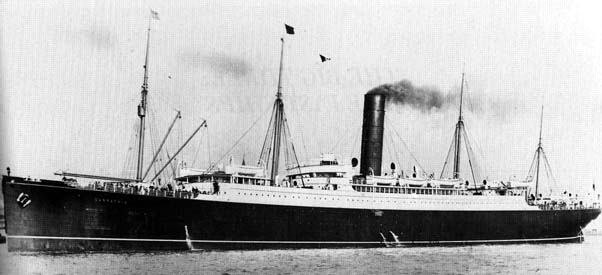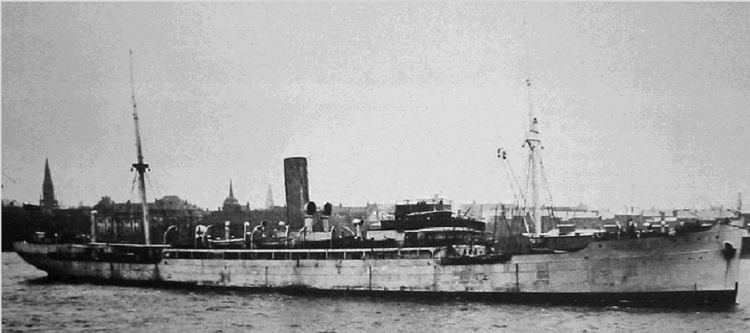Name SS Mount Temple Maiden voyage 19 September 1901 Length 148 m Draft 9.3 m Builder Armstrong Whitworth | Yard number 709 Fate Sold to US Launched 18 June 1901 Beam 18 m | |
 | ||
Namesake William Francis Cowper (1811-1888), Baron Mount Temple Owner Elder Dempster's Beaver Line | ||
The SS Mount Temple was a Canadian Pacific Lines cargo ship that was sunk during the First World War by the German commerce raider SMS Möwe.
Contents

Originally a Beaver Line ship, she was purchased by Canadian Pacific in 1903. She was one of the ships that responded to the distress signals of the RMS Titanic in 1912.

In 1916, while crossing the Atlantic with horses for the war effort and carrying a large number of newly collected dinosaur fossils (two of which were the hadrosaurs Corythosaurus), she was captured and scuttled complete with her cargo.

Early history

Mount Temple was built in 1901 in Walker-on-Tyne, England by Armstrong Whitworth & Company. The ship was launched for the Elder Dempster's Beaver Line on 18 June 1901.

The ship was named for William Francis Cowper (1811–1888), Baron Mount Temple, an English politician, Lord of the Admiralty and chairman of Armstrong-Whitworth. The ship was 8,790 gross tons and was 485 feet long. She had one funnel, four masts, twin screw propellers, and a top speed of 13 knots.
Mount Temple saw use in November 1901 as a transport ship during the Second Boer War .
In 1903, Canadian Pacific Lines purchased the ship, with 14 others, and equipped her with a wireless telegraph. In the early days of wireless telegraphy, the call sign established for the SS Mount Temple was "MLQ."
After two successful Liverpool–Quebec City runs in 1903, the ship ran aground on West Ironbound Island, Nova Scotia on 2 December 1907. No lives were lost, but the ship was stranded until 1908, when she was refloated.
Assisting the RMS Titanic
The SS Mount Temple set out on 3 April 1912 under the command of Captain James Henry Moore, setting sail from Antwerp bound for St John's, New Brunswick, transporting over 1400 immigrants to Canada. Moore was a highly experienced ship's master with over 30 years logged at sea.
On the night of 14–15 April, Mount Temple's lone Marconi wireless operator, John Durrant, was about to sign off for the evening at around 12:30 a.m. ship's time when he picked up the distress signal from RMS Titanic, which had its encounter with an iceberg. He had the message relayed to the bridge by a steward. Captain Moore had standing orders to avoid icebergs, but after receiving the distress call he decided to mount a rescue operation. He had Durrant respond to the CQD, then immediately turned his ship around and steamed north-northeast at the vessel's maximum speed of 11.5 knots (13.2 mph; 21.2 km/h) towards Titanic's reported position. He consulted with his chief engineer, John Gillet, to try to coax even more speed out of the ageing vessel. Moore worked out his own rough position as 41° 25' N, 51° 14' W, approximately 49 mi (78 km) away. Even at full speed, it would take around 4 hours to cover the distance between his ship and Titanic.
Once underway, Moore had his off duty crew awakened and briefed and ordered the 20 lifeboats aboard uncovered. He had ropes and ladders readied, lifebelts prepared and posted extra lookouts to aid avoiding the icebergs reported in the area. Initial progress was good but after finding his ship coming upon a large ice field at around 3:00 a.m., the ship slowed until becoming increasingly surrounded by pack ice. Around this time, Mount Temple encountered a single funnel steamer, which went unidentified and caused the ship to take evasive action. At that point, Moore sighted green lights and bright decklights approaching at around 3:20 a.m. This would later prove to be flares fired from Titanic's lifeboats and rockets from the RMS Carpathia, steaming up from the south east. With the amount of ice becoming ever greater, Mount Temple heaved to around 14 miles short of the wreck site. At first light at 5:30 a.m., Moore ordered the ship to resume course at low speed, navigating the ice floe. Once clear, Moore and his crew proceeded to the last known position of Titanic, but found no traces or wreckage. Later on using dead reckoning, he calculated that the given position was incorrect, with the actual location around 8 miles further east.
Arriving at the correct SOS position at around 6:30 a.m., Mount Temple combed the area and sighted Carpathia commanded by Captain Arthur Rostron, but was too late to assist. Carpathia was engaged in picking up the remaining survivors. The two ships sighted the SS Californian steaming toward them from the north shortly afterwards at 8:00 a.m. After communicating with Captain Rostron, Mount Temple conducted a further search of the area but found nothing, and Moore gave the order to continue the voyage to New Brunswick. Once Mount Temple had docked, he was summoned to the American and later British inquests into the sinking.
Controversy abounds concerning Moore's recollections of the Mount Temple's true speed on the evening of 14 April 1912, how far away she was from the distress position when she turned to help, and how far she was from Titanic when she stopped. Rumors that Mount Temple under Moore ignored Titanic's distress rockets abounded at the time and persist to this day. It is said that Mount Temple was the "mystery ship" seen by officers and passengers aboard the Titanic five to ten miles away, rather than the SS Californian as implied by Lord Mersey and the British Board of Trade at the British Inquiry. These rumours are strongly contested however, and many continue to firmly believe that the Californian must have been the ship seen from the Titanic, and vice versa.
War service and loss
For use during World War I she had a 3-inch (75 mm) gun mounted on her stern for defensive purposes.
The Mount Temple departed from Montreal on 3 December 1916 for Brest, France, and then Liverpool, England, with Captain Alfred Henry Sargent at the helm. The ship's cargo was 710 horses and 6,250 tons of goods, including 3,000 tons of corn, and 1,400 cases of eggs. Also on board were 22 wooden crates of dinosaur fossils, collected in the Badlands of Alberta by the American paleontologist Charles H. Sternberg. These were en route to Sir Arthur Smith Woodward, keeper of the British Museum's Natural History Department.
The ship was captured roughly halfway between Cape Race and Spain, roughly 2,000 km (1,200 mi) north of the Azores on 6 December 1916. The SMS Möwe, outwardly a cargo ship, closed with the Mount Temple. After the gun crew of the Mount Temple fired, the Germans fired back and with their superior firepower silenced the gun. Four crew members aboard the Mount Temple were killed in the brief battle. Over a hundred crew and passengers were taken off before explosives were used to help scuttle her. On 12 December 1916, they were brought aboard the captured British ship Yarrowdale and they arrived at Swinemunde, Germany on 31 December. The US citizens among them were released in early March 1917 as the United States was neutral at the time. The others were interned as prisoners of war.
The Mount Temple was the fourth vessel that Canadian Pacific Lines lost during the First World War, and by the war's end, CP Lines would lose a total of 18 ships. Its sister ship (the SS Montezuma) was torpedoed and sunk by the German submarine UC-41 on 25 July 1917.
Crew members lost
The four crew members lost on 6 December were:
